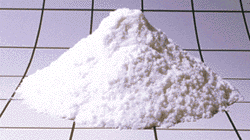Greenhouse Soil Mixtures
There are all sorts of different types of soil mixtures that greenhouse producers like to use. Depending on location, the components often vary in some form, either because of economic, natural, or personal reasons. I have worked in a greenhouse in southern Michigan, and the soil mixture that is used by Red Barn Greenhouse is one of teh most common mixtures used in all greenhouse operations. I will describe and inform people of this mixture.
Peat Moss
Peat moss is the decomposed remains of plants in bougs and is largely grown in Canada. Over many years, the decomposed remains form a rich layer of soil that acts as a sponge and soaks up water it the boug. Because of this trait, peat moss is an ideal soil for greenhouse crops. Peat moss is light and arid, and this makes for great plant growth and easy moving of the pots of plants. Peat is also very nice to use because it soaks up water and absorbed minerals and nurtients for the plants to use.
Perlite

Perlite is a volcanic rock or mineral that when heated at 1600 degrees F expands 13 times its origional volume. Perlite acts as a bubble in the soil, thus creating areas for great aeration. This aeration helps plant roots grow rapidly and that effects the whloe plant growth rate. Because plant roots need air for growth, perlite is used in mixtures to aid in areation and because it is very light, small and inexpensive to use. When using perlite, there are different sizes that are available for mixes. The coarse size is large with the fine being very small and ground up. Most greenhouses use larger sizes because as the plants grow and watering becomes more extensive, the particles break down into smaller sizes. As you can see, perlite is white and is neutral in pH. It is also tasteless, but it is very dusty.
Vermiculite
Vermiculite is also a mineral that is heated to expand its volume. Once heated, it forms a wormlike and accordian shape. Vermiculite is very light just like perlite which helps in movement of pots. Just like perlite, vermiculite is tasteless and odorless, but vermiculite is not nearly as dusty. Most of the time the pH of vermiculite is neutral, but sometimes it can become more alkaline. Vermiculite is used mainly because od its help wit aeration and plant growth, but more so because it will soak up water and nutrients and as the roots grow around the vermiculite particles the water and nutirents are released as needed. The size of the particles are the same as perlite, and like perlite, the larger sized particles are used more often.
These are the three main components of most greenhouse soils. Depending on location, other ingredients are added to perform specific tasks, such as limestone, sand, compost, or other materials. Depending on the location of the greenhouse, different amounts of all these materials are used to create this growing media. However, because of teh avilability of all three, they are all used in great amounts because of their success together.
Sources used: